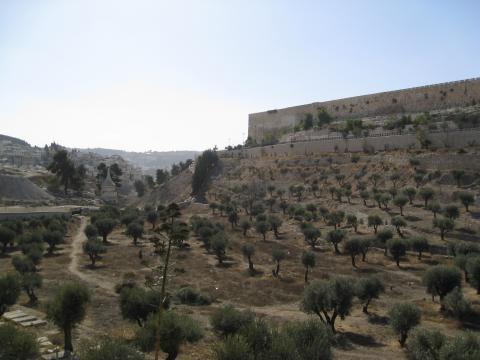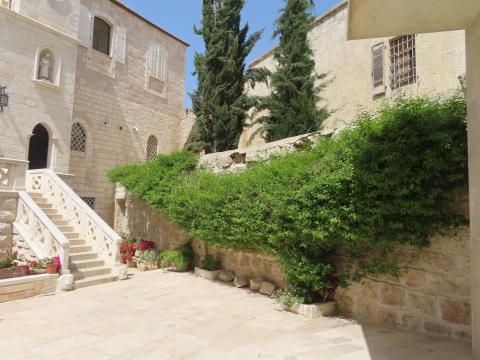The Siege of Jerusalem
[10.37.1] Remānsit ipse illīc cum gaudiō; nōs autem, laetantēs et exultantēs, usque ad cīvitātem Hierusalem pervēnimus fēriā tertiā, VIII Īdūs Iūniī, eamque mīrābiliter obsēdimus. Rotbertus namque Nortmannus eam obsēdit ā septentriōne, iuxtā sānctī Stephanī Prothomartyris ecclēsiam, ubi lapidātus est prō nōmine Chrīstī. Iuxtā Robertum, Flandrēnsis comes. Ab occidente vērō obsēdit eam dux Godefridus et Tancredus. Ā merīdiē obsēdit eam comes Sānctī Egidīī, scīlicet in monte Sīōn circā ecclēsiam sānctae Mariae mātris Dominī, ubi Dominus cum suīs cēnāvit discipulīs.
notes
(June 1099) The crusaders besiege Jerusalem on the north, the west, and the south. The steep Quidron (Kidron) Valley has made the city inaccessible from the east).
Remānsit ipse illīc: sc. epīscopus.
fēriā tertiā, VIII Īdūs Iūniī: Tuesday, June 6, though the real date was June 7.
mīrābiliter obsēdimus: “we besieged it wonderfully (well).”
iuxtā sānctī Stephanī Prothomartyris ecclēsiam: i.e., on the north, opposite the Damascus Gate (called St. Stephen's Gate by the crusaders). Stephen "dragged out of the city" and stoned to death for his Christian faith, and was thus called “protomartyr,” i.e., “the first martyr” (Acts 7:54–59). This church is now the Church of Saint Etienne (St. Stephen).
ubi lapidātus est prō nōmine Chrīstī: sc. Stephanus.
Iuxtā Robertum, Flandrēnsis comes: = comes Flandrēnis (erat) iuxtā Robertus.
obsēdit eam: = obsēdit (cīvitātem Hierusalem).
in monte Sīōn: Mount Sion (Zion) and the steep Kidron Valley made it difficult to attack Jerusalem from the east.
circā ecclēsiam sānctae Mariae mātris Dominī: this was the Byzantine church of Hagia Maria Sion, now the Abbey of the Dormition.
ubi Dominus cum suīs cēnāvit discipulīs: i.e., this was thought to be the site of the Last Supper.
vocabulary
feria –ae, f.: religious festival, holiday, day of rest; an ordinary day.
cēnō (1): to dine



